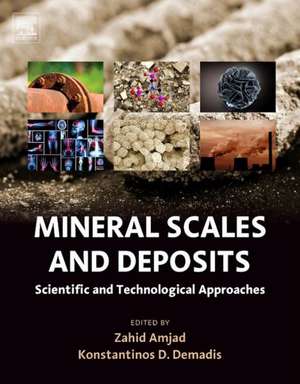Mineral Scales and Deposits: Scientific and Technological Approaches
Editat de Zahid Amjad, Konstantinos D. Demadisen Limba Engleză Hardback – 22 mai 2015
It covers several fundamental aspects, also offering an applications’ perspective, with the ultimate goal of helping the reader better understand the underlying mechanisms of scale formation, while also assisting the user/reader to solve scale-related challenges.
It is ideal for scientists/experts working in academia, offering a number of crystal growth topics with an emphasis on mechanistic details, prediction modules, and inhibition/dispersion chemistry, amongst others. In addition, technologists, consultants, plant managers, engineers, and designers working in industry will find a field-friendly overview of scale-related challenges and technological options for their mitigation.
- Provides a unique, detailed focus on scale deposits, includes the basic science and mechanisms of scale formation
- Present a field-friendly overview of scale-related challenges and technological options for their mitigation
- Correlates chemical structure to performance
- Provides guidelines for easy assessment of a particular case, also including solutions
- Includes an extensive list of industrial case studies for reference
Preț: 1054.97 lei
Preț vechi: 1159.31 lei
-9% Nou
Puncte Express: 1582
Preț estimativ în valută:
201.93€ • 219.42$ • 169.73£
201.93€ • 219.42$ • 169.73£
Carte tipărită la comandă
Livrare economică 15-29 aprilie
Preluare comenzi: 021 569.72.76
Specificații
ISBN-13: 9780444632289
ISBN-10: 044463228X
Pagini: 784
Ilustrații: 50 illustrations
Dimensiuni: 216 x 276 x 69 mm
Greutate: 2.08 kg
Editura: ELSEVIER SCIENCE
ISBN-10: 044463228X
Pagini: 784
Ilustrații: 50 illustrations
Dimensiuni: 216 x 276 x 69 mm
Greutate: 2.08 kg
Editura: ELSEVIER SCIENCE
Public țintă
Chemists, Chemical Engineers, Water Technologists, Plant Managers, Consultants, Graduate Students, Geologists and Technologists/Formulators involved in Consumer Products DevelopmentCuprins
Section 1: Fouling and Scaling Fundamentals
1. Water-Formed Scales and Deposits: Types, Characteristics, and Relevant Industries
2. Water Chemistry and its Role in Industrial Water Systems
3. Mechanisms of Scale Formation and Inhibition
4. Corrosion inhibitors in cooling water systems
5. The Mineralogy of Microbiologically Influenced Corrosion
6. Biofouling in Industrial water Systems
7. Particulate Matter: Interfacial Properties, Fouling, and its Mitigation
8. Water Treatment Chemicals: Types, Solution Chemistry, and Applications
9. Non-Chemical Methods to Control Scale and Deposit Formation
10. New Product Development for Oilfield Application
11. Patent Review related to Scale and Scale Inhibition
Section 2: Biological, Environmental and Home Care
12. Scaling Problems in Home Care Applications
13. Tartar and Plaque Control
14. Calcium Pyrophosphate Dihydrate Deposition Disease
15. Importance of Calcium based Scales in Kidney Stones
16. Calcification of Biomaterials
17. Withdrawn: Deposits on Hair and Skin: Types, Characterization, and Removal
18. Withdrawn: Legionella in Water Systems
19. Removal of Toxic Materials from Aqueous Streams
Section 3: Scaling and Fouling Issues by Industry
20. Membrane Based Desalination: Challenges and Solutions
21. Cooling Water Systems: An Overview
22. Withdrawn: Managing an Open Recirculating Water System from Start Up to Turn Around
23. Equipment Fouling in dairy processes
24. Scaling in Alkaline Spent Pulping Liquor Evaporators
25. Control of Silica-based Scales in Cooling and Geothermal Systems
26. Thermal Distillation: Current Challenges
27. Oilfield Mineral Scale Control
28. Scale Control in Sugar Evaporators
29. Scale Formation in Tungston Hydrometallurgical Process
Section 4. Systems Support and Maintenance
30. Analytical Techniques to Characterize Scales and Deposits
31. Removal/Dissolution of Scale Deposits
32. Scaling Indices: Types and Applications
33. On-Line Monitoring of Water Treatment Chemicals
1. Water-Formed Scales and Deposits: Types, Characteristics, and Relevant Industries
2. Water Chemistry and its Role in Industrial Water Systems
3. Mechanisms of Scale Formation and Inhibition
4. Corrosion inhibitors in cooling water systems
5. The Mineralogy of Microbiologically Influenced Corrosion
6. Biofouling in Industrial water Systems
7. Particulate Matter: Interfacial Properties, Fouling, and its Mitigation
8. Water Treatment Chemicals: Types, Solution Chemistry, and Applications
9. Non-Chemical Methods to Control Scale and Deposit Formation
10. New Product Development for Oilfield Application
11. Patent Review related to Scale and Scale Inhibition
Section 2: Biological, Environmental and Home Care
12. Scaling Problems in Home Care Applications
13. Tartar and Plaque Control
14. Calcium Pyrophosphate Dihydrate Deposition Disease
15. Importance of Calcium based Scales in Kidney Stones
16. Calcification of Biomaterials
17. Withdrawn: Deposits on Hair and Skin: Types, Characterization, and Removal
18. Withdrawn: Legionella in Water Systems
19. Removal of Toxic Materials from Aqueous Streams
Section 3: Scaling and Fouling Issues by Industry
20. Membrane Based Desalination: Challenges and Solutions
21. Cooling Water Systems: An Overview
22. Withdrawn: Managing an Open Recirculating Water System from Start Up to Turn Around
23. Equipment Fouling in dairy processes
24. Scaling in Alkaline Spent Pulping Liquor Evaporators
25. Control of Silica-based Scales in Cooling and Geothermal Systems
26. Thermal Distillation: Current Challenges
27. Oilfield Mineral Scale Control
28. Scale Control in Sugar Evaporators
29. Scale Formation in Tungston Hydrometallurgical Process
Section 4. Systems Support and Maintenance
30. Analytical Techniques to Characterize Scales and Deposits
31. Removal/Dissolution of Scale Deposits
32. Scaling Indices: Types and Applications
33. On-Line Monitoring of Water Treatment Chemicals


























